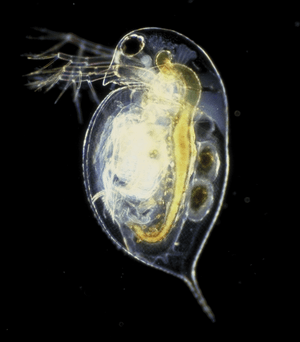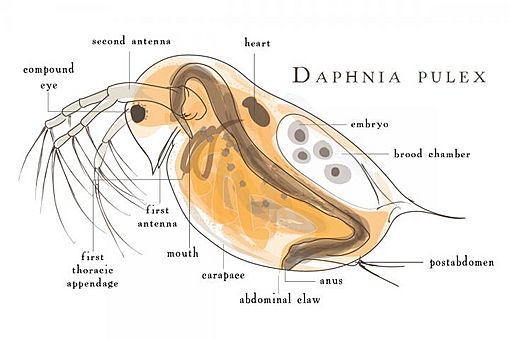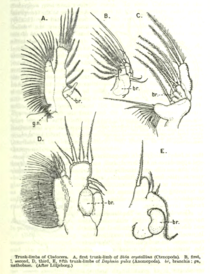Daphnia facts for kids
Quick facts for kids Daphnia |
|
|---|---|
 |
|
| Daphnia pulex | |
| Scientific classification |
|
| Unrecognized taxon (fix): | Anomopoda |
| Family: | Daphniidae |
| Genus: | Daphnia Müller, 1785 |
| Subgenera | |
|
|
| Diversity | |
| > 200 spp. | |
| Synonyms | |
|
|
Daphnia is a group of tiny crustaceans that live in water. They are usually between 0.2 and 6.0 millimeters long. People often call them "water fleas" because they swim with a jumping motion, a bit like how fleas move. Daphnia species can be found in many different watery places, from acidic swamps to freshwater lakes and ponds.
There are over 200 different kinds of Daphnia. The two most common types are D. pulex, which is small, and D. magna, which is larger. They are related to another tiny water creature called Moina, but Moina is much smaller.
Contents
What Does a Daphnia Look Like?
A Daphnia's body is usually 1 to 5 millimeters long. It is divided into parts, but you can't easily see these divisions. Their head is usually bent down towards their body. Most Daphnia have a shell-like covering called a carapace. This shell has an opening underneath where their five or six pairs of legs are.
The most noticeable parts of a Daphnia are its compound eyes and its two large antennae. Many Daphnia species have bodies that are clear or see-through. This makes them great to look at under a microscope. You can even see their heart beating!
Under a microscope, you can watch how they eat. You can also see their tiny babies moving inside them. Their eye moves, and you can see blood cells being pumped around their body by their simple heart. The heart is at the top of their back, just behind their head. It usually beats about 180 times per minute.
Daphnia are often used in science experiments. Because their bodies are clear, scientists can easily study how different chemicals affect their heart rate. For example, some substances can make their heart beat faster or slower.
How Daphnia Live and Behave
Daphnia usually have short lives. Their lifespan depends on things like water temperature and how many predators are around. In very cold lakes with no fish, they might live for 13 to 14 months. But usually, they live for a much shorter time, often only 5 to 6 months.
Daphnia are mostly filter feeders. This means they eat tiny bits of food floating in the water. They mainly eat single-celled algae, tiny protists, and bacteria. Their legs beat constantly, creating a current that pulls food into their mouth. The food then goes into their digestive system. Their second and third pairs of legs help them filter out large particles they can't eat.
Daphnia swim by using their second set of antennae. These antennae are larger than the first set. When they move these antennae, it makes them jump through the water.
Daphnia can also change their behavior or even their body shape when they sense predators nearby. They do this by detecting special chemical signals from predators. For example, young Daphnia pulex can grow larger and develop "neck-teeth" on the back of their heads if they sense predators like Chaoborus larvae. These changes help them survive by making it harder for predators to eat them.
Daphnia Life Cycle
For most of the year, female Daphnia lay eggs without needing a male. These eggs develop into new females. They lay a new batch of eggs every time they shed their skin. Smaller species might lay only one or two eggs, while larger species like Daphnia magna can lay over 100 eggs at once. These eggs usually hatch in about a day.
When conditions in the water get tough, like when there's not enough food or too many Daphnia in one place, they change how they reproduce. Some of the new babies will grow into males. The females then start producing different kinds of eggs that need to be fertilized by the males.
These fertilized eggs are called "resting eggs" or "winter eggs." They are protected by a tough, hard shell called an ephippium. The female sheds these eggs when she molts. These special eggs can survive very cold weather, dry periods, or times when there's not much food. When conditions get better, these resting eggs hatch, and new female Daphnia emerge.
Daphnia and Parasites
Like many animals, Daphnia can get sick from parasites. One example is a bacteria called Pasteuria ramosa. Daphnia get infected by tiny spores of this bacteria from the water or mud. The bacteria then grow inside the Daphnia's body.
When a Daphnia is infected, it might become unable to have babies. It might also grow larger than normal. The bacteria spores are released when the infected Daphnia dies and sinks to the bottom.
Protecting Daphnia Species
Some Daphnia species are considered threatened. The IUCN lists species like Daphnia nivalis and Daphnia coronata as vulnerable. Some Daphnia can even live in very salty lakes, like the Makgadikgadi Pan.
How People Use Daphnia
Daphnia are very popular as live food for pet fish in aquariums. They are also fed to tadpoles and small frogs.
Scientists also use Daphnia in their studies. They are considered a "model organism" because they are easy to study. Because they have short lives and reproduce quickly, they are good for testing how toxins affect an ecosystem. This makes them an indicator species, showing if the water is healthy.
Since their bodies are almost clear, scientists can easily see their internal organs. This allows them to study how things like temperature or certain chemicals affect their heart rate.
Invasive Daphnia Species
Some Daphnia species have developed special defenses against fish. They have long spines or hooks on their bodies. These hooks make it hard for fish to eat them. They can also get tangled on fishing lines and make the water cloudy if there are too many of them.
One example is Daphnia lumholtzi, which comes from places like Africa, India, and Australia. This species has these hooks and spines. It's important to stop them from spreading to new places, especially in North America, where they are not native.
Some Daphnia species that are native to North America can also grow sharp spines or helmet-like shapes on their heads when they sense predators. However, these changes are usually temporary. While Daphnia are an important food source for many animals in freshwater lakes, invasive species can sometimes cause problems. They might outcompete the native Daphnia or simply become a nuisance by tangling fishing gear.
Around the world, at least 15 different types of Daphnia and their mixes are not native to where they are found. Many of these can cause big problems for the water ecosystems.
See also
 In Spanish: Daphnia para niños
In Spanish: Daphnia para niños










